|
|
|
Sort Order |
|
|
|
Items / Page
|
|
|
|
|
|
|
| Srl | Item |
| 1 |
ID:
132595


|
|
|
|
|
| Publication |
2014.
|
| Summary/Abstract |
This paper quantifies the direct rebound effects associated with the switch from incandescent lamps (ILs) or halogen bulbs to more energy efficient compact fluorescent lamps (CFLs) or light emitting diodes (LEDs) using a large nationally representative survey of German households. The direct rebound effect is measured as the elasticity of energy demand for lighting with respect to changes in energy efficient lamps. In particular, the rebound effect is decomposed into changes in lamp luminosity and burn time. For the average bulb, the associated total direct rebound effect is estimated at about 6%. The larger part (around 60%) of this rebound effect results from increases in bulb luminosity. For the most frequent (modal) bulb switch, i.e. the replacement of the main bulb in the living or dining room, the total direct rebound effect is just below 3%, with around 60% attributable to an increase in burn time. Average and modal bulb differences suggest that the magnitude of the rebound effect may decrease with intensity of initial bulb use. The magnitude of the direct rebound and the relative contributions of changes in luminosity and burn time also differ by initial bulb type and by replacement bulb type.
|
|
|
|
|
|
|
|
|
|
|
|
|
|
|
|
| 2 |
ID:
132610


|
|
|
|
|
| Publication |
2014.
|
| Summary/Abstract |
The United States is in need of a new and more adaptive long-term strategy for spent nuclear fuel. In this communication, we outline the fundamental reasons why deep borehole disposal should receive more detailed investigation, alongside traditional shallow mined repositories. This potential solution is supported by advancing drilling technologies and an improving understanding of extremely long fluid residence times in deep bedrock. Radionuclide isolation is supported by verifiable and stable geologic barriers such as long transport distances to aquifers, low permeability, and reducing chemical conditions. The modular nature of implementing deep borehole disposal could offer unique programmatic and economic advantages. Experience with a pilot borehole program will be required to confirm the feasibility of drilling and emplacement operations, and key chemical and hydraulic conditions.
|
|
|
|
|
|
|
|
|
|
|
|
|
|
|
|
| 3 |
ID:
132607
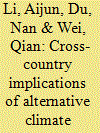

|
|
|
|
|
| Publication |
2014.
|
| Summary/Abstract |
Because of worldwide growing concerns about global climate change, great interest has been expressed in the potential of alternative climate policies to reduce global carbon emissions. In this paper, we compare cross-country implications of alternative climate policies, including unilateral and multilateral climate policies. Our main findings are as follows. Firstly, there are large differences in cross-country effects of alternative unilateral climate policies, when the same given carbon emission reductions are achieved in each abating country respectively. Meanwhile, cross-border externalities undermine efficiency of unilateral climate policies. Secondly, there are significant differences in cross-country implications of alternative multilateral climate policies, when the same global emission reductions are allocated in several different ways among abating countries. Thirdly, it is difficult to reach a stable global climate treaty, since any abating country has the incentive to argue for small carbon emission reductions. Finally, multilateral climate policies can reduce the negative impacts of cross-border externalities, but cannot cure all cross-border externalities. Looking ahead, it will be a great policy challenge for the world to reduce carbon emissions in a cost-effective way.
|
|
|
|
|
|
|
|
|
|
|
|
|
|
|
|
| 4 |
ID:
132597


|
|
|
|
|
| Publication |
2014.
|
| Summary/Abstract |
Incentives are policy tools that sway purchase, retail stocking, and production decisions toward energy-efficient products. Incentives complement mandatory standards and labeling policies by accelerating market penetration of products that are more energy efficient than required by existing standards and by preparing the market for more stringent future mandatory requirements. Incentives can be directed at different points in the appliance×s supply chain; one point may be more effective than another depending on the technology×s maturity and market penetration. This paper seeks to inform future policy and program design by categorizing the main elements of incentive programs from around the world. We identify advantages and disadvantages of program designs through a qualitative overview of incentive programs worldwide. We find that financial incentive programs have greater impact when they target highly efficient technologies with a small market share, and that program designs depend on the market barriers addressed, the target equipment, and the local market context. No program design is inherently superior to another. The key to successful program design and implementation is a thorough understanding of the market and identification of the most important local obstacles to the penetration of energy-efficient technologies.
|
|
|
|
|
|
|
|
|
|
|
|
|
|
|
|
| 5 |
ID:
132604


|
|
|
|
|
| Publication |
2014.
|
| Summary/Abstract |
The United Kingdom is aspiring to reduce the carbon emissions in the building sector, aiming to achieve nearly zero carbon buildings by 2020. The policy models in England and Wales rely on three strands: regulations; financial incentives and educational schemes. A growing body of literature suggests that the building industry is facing several barriers that hinder the delivery of the expected carbon targets outlined at policy level. This research explores the enactment of the policy aspirations by building designers using a bottom-up approach. An ethnographic study was conducted to analyse the design process of six non-domestic buildings. The work identified the designers× responses to adopt the policy agenda in routine design and overcome the challenges that emerged during the design process. The understanding of the designers× responses could inform the policy model and suggest areas that need attention for the timely delivery of the expected carbon reductions.
|
|
|
|
|
|
|
|
|
|
|
|
|
|
|
|
| 6 |
ID:
132594


|
|
|
|
|
| Publication |
2014.
|
| Summary/Abstract |
Whereas the technical feasibility of solar water heaters (SWHs) has long been established, the economic feasibility of SWHs in regional China remains to be examined. This paper constructs cost models to calculate costs per unit energy saving of SWHs in 27 Chinese provincial capital cities. The cost effectiveness of SWHs is examined at the national level. At a micro level, we analyze the financial attractiveness of consumers' investment in SWHs. A panel data model is employed to evaluate the effectiveness of a subsidy program in rural China. The results show that SWH costs, ranging from 0.305 to 0.744 CNY/kW h, are much lower than those of other major renewable energies across China. This finding indicates that the diffusion of SWHs is a cost-effective way to reach China's renewable energy target. For consumers, incentive programs for SWHs are needed to improve the financial attractiveness of the devices in China. Existing subsidy policies for rural China have failed to significantly enhance the deployment of SWHs. The causes of the failure are examined and a new incentive program is suggested for rural areas of the country.
|
|
|
|
|
|
|
|
|
|
|
|
|
|
|
|
| 7 |
ID:
132611
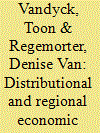

|
|
|
|
|
| Publication |
2014.
|
| Summary/Abstract |
We analyse the macroeconomic and distributional effects of increased oil excises in Belgium by combining a regional Computable General Equilibrium (CGE) model with a microsimulation framework that exploits the rich detail of household-level data. The link between the CGE model and the microlevel is top-down, feeding changes in commodity prices, factor returns and employment by sector into a microsimulation model. The results suggest that policymakers face an equity-efficiency trade-off driven by the choice of revenue recycling options. When the additional revenue is used to raise welfare transfers to households, the reform is beneficial for lower income groups, but output levels decrease in all regions. However, when the energy tax revenue is used to lower distortionary labour taxes, the tax shift is slightly regressive. In this case, national GDP is hardly affected but regional production levels diverge. The impact of the environmental tax reform on income distribution depends strongly on changes in factor prices and welfare payments, whereas sector composition is an important determinant for regional impact variation.
|
|
|
|
|
|
|
|
|
|
|
|
|
|
|
|
| 8 |
ID:
132599
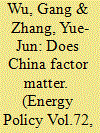

|
|
|
|
|
| Publication |
2014.
|
| Summary/Abstract |
Whether China's crude oil imports are the culprit of oil price volatility these years has not been quantitatively confirmed. Therefore, this paper empirically investigates the role of China's crude oil net imports in Brent price changes from October 2005 to November 2013 based on an econometric analysis. The results indicate that, during the sample period, China's crude oil imports do not significantly affect Brent price changes, no matter in the long run or short run. Therefore, the blame for China's crude oil imports to cause the dramatic fluctuations of international oil price has no solid evidence. Also, there exists significant uni-directional causality running from the Brent price to China×s crude oil imports at the 5% level. Besides, the response of the Brent price to China×s crude oil imports is found positive but slight, and the Brent price responds more significantly to US dollar exchange rate and OECD commercial inventory than to China's crude oil imports in the short run. Finally, the contribution of China×s crude oil imports to Brent price movement is about 10%, which is less than that of US dollar exchange rate but larger than that of Indian crude oil imports or OECD commercial inventory.
|
|
|
|
|
|
|
|
|
|
|
|
|
|
|
|
| 9 |
ID:
132603


|
|
|
|
|
| Publication |
2014.
|
| Summary/Abstract |
We propose a competitiveness index for the electricity industry based on efficiency, stability, and growth factors identified from previous studies subject to data accessibility. These are then weighted appropriately through the application of the analytical hierarchy process. This index is an alternative tool to capture the diverse characteristics of the electricity industry in order to analyze performance after deregulation. Using the competitiveness index, we analyze the effect of regulation change in specific economic environments represented by the level of economic development, energy intensity, and manufacturing share, for example. According to the results, deregulation generally increases competitiveness, but the effect depends on the economic environment and the type of regulation. Deregulating entry and vertical integration to increase competitiveness is more effective in countries where the level of economic development, energy intensity, and manufacturing share are low. The manner in which the privatization effect is related to the economic environment is, however, unclear.
|
|
|
|
|
|
|
|
|
|
|
|
|
|
|
|
| 10 |
ID:
132592


|
|
|
|
|
| Publication |
2014.
|
| Summary/Abstract |
Forecasting of electricity demand has assumed a lot of importance to provide sustainable solutions to the electricity problems. LEAP has been used to forecast electricity demand for the target year 2030, for the state of Maharashtra (India). Holt's exponential smoothing method has been used to arrive at suitable growth rates. Probable projections have been generated using uniform gross domestic product (GDP) growth rate and different values of elasticity of demands. Three scenarios have been generated which include Business as Usual (BAU), Energy Conservation (EC) and Renewable Energy (REN). Subsequent analysis on the basis of energy, environmental influence and cost has been done. In the target year 2030, the projected electricity demand for BAU and REN has increased by 107.3 per cent over the base year 2012 and EC electricity demand has grown by 54.3 per cent. The estimated values of green house gas (GHG) for BAU and EC, in the year 2030, are 245.2 per cent and 152.4 per cent more than the base year and for REN it is 46.2 per cent less. Sensitivity analysis has been performed to study the effect on the total cost of scenarios. Policy implications in view of the results obtained are also discussed.
|
|
|
|
|
|
|
|
|
|
|
|
|
|
|
|
| 11 |
ID:
132600
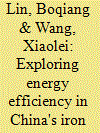

|
|
|
|
|
| Publication |
2014.
|
| Summary/Abstract |
The iron and steel industry is one of the major energy-consuming industries in China. Given the limited research on effective energy conservation in China×s industrial sectors, this paper analyzes the total factor energy efficiency and the corresponding energy conservation potential of China×s iron and steel industry using the excessive energy-input stochastic frontier model. The results show that there was an increasing trend in energy efficiency between 2005 and 2011 with an average energy efficiency of 0.699 and a cumulative energy conservation potential of 723.44 million tons of coal equivalent (Mtce). We further analyze the regional differences in energy efficiency and find that energy efficiency of Northeastern China is high while that of Central and Western China is low. Therefore, there is a concentration of energy conservation potential for the iron and steel industry in the Central and Western areas. In addition, we discover that inefficient factors are important for improving energy conservation. We find that the structural defect in the economic system is an important impediment to energy efficiency and economic restructuring is the key to improving energy efficiency.
|
|
|
|
|
|
|
|
|
|
|
|
|
|
|
|
| 12 |
ID:
132601
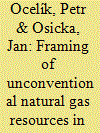

|
|
|
|
|
| Publication |
2014.
|
| Summary/Abstract |
The advent of unconventional resources of natural gas has altered the order on global as well as continental gas markets. With rising liquidity, the position of established dominant suppliers is eroding. We focus on the initial response of Russia, the leading supplier of natural gas to Europe, to the new situation, building the research on unit-level constructivism and discourse analysis. We use frame analysis to reveal what image of unconventional resources was constructed in Russian foreign energy policy discourse (FEPD) in the period between 2009 and 2011, when the "unconventional revolution" did not yet have any sharp contours. We conclude that in Russian FEPD the unconventionals are considered as a distinctive and inferior source of energy compared to conventional natural gas. Emphasis is put on their economic irrationality and environmental hazards. The bottom line of the discourse is the idea that there is a choice between conventional and unconventional sources, with this choice being framed as one between good and bad, or right and wrong.
|
|
|
|
|
|
|
|
|
|
|
|
|
|
|
|
| 13 |
ID:
132609
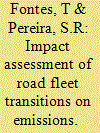

|
|
|
|
|
| Publication |
2014.
|
| Summary/Abstract |
This paper aims to examine the impacts of fleet composition changes on emission due to the introduction of different road transportation policies in a medium size European country (Portugal) applying an ex-post analysis (e.g. policies based on fuel pricing, car scraping, car taxation). A baseline scenario was compared with a counterfactual scenario in order to understand what would occur in the absence of the introduction of those policies. For each scenario, four approaches were assessed using economic effects and/or human health costs. HC, CO, NOx, PM and CO2 emissions from passenger cars and light duty vehicles were evaluated. The results show high statistical significance (p?0.05) between CO emissions and different vehicle features as vehicle age, fuel type and engine classes. The same pattern was observed between the average vehicle age and HC, NOx and PM. After the implementation of road traffic policies, the average emission factors of the fleet decreased 28-62% for HC, CO, NOx, PM and 20-39% for CO2. However, if a counterfactual scenario would be implemented, the reduction would be 20-80% and 26-55% higher, respectively. The results demonstrates that although were recorded some benefits, the fleet characteristics distribution were more environmental friendly in 2001 than in 2011.
|
|
|
|
|
|
|
|
|
|
|
|
|
|
|
|
| 14 |
ID:
132593


|
|
|
|
|
| Publication |
2014.
|
| Summary/Abstract |
Feed-in tariffs (FiTs) offer renewable energy developers significant investor certainty but sometimes at the cost of being misaligned with generation costs. Reverse FiT auctions, where the FiT rights for a predetermined capacity are auctioned, can overcome this problem but can be plagued by non-delivery risks, particularly of competitively priced proposals. In 2012 and 2013 the Australian Capital Territory (ACT) Government in Australia conducted a FiT reverse auction for 40 MW of large-scale solar generating capacity, the first such auction undertaken in the country. The auction was highly competitive in relation to price and demonstrating low delivery risks. Proposal capital costs, particularly engineering, procurement and construction costs, as well as internal rates of return, were lower than expected. The auction process revealed limited land availability for large-scale solar developments in the ACT as well as a significant perceived sovereign risk issue. The auction process was designed to mitigate non-delivery risk by requiring proposals to be pre-qualified on the basis of delivery risk, before considering FiT pricing. The scheme is likely to be used by the ACT Government to support further large-scale renewable energy development as part of its greenhouse gas reduction strategy which is underpinned by a 90-per cent-by-2020 renewable energy target.
|
|
|
|
|
|
|
|
|
|
|
|
|
|
|
|
| 15 |
ID:
132616


|
|
|
|
|
| Publication |
2014.
|
| Summary/Abstract |
Energy lies at the backbone of any advanced society and constitutes an essential prerequisite for economic growth, social order and national defense. However there is an Achilles heel to today×s energy and technology relationship; namely a precarious intimacy between energy and the fiscal, social, and technical systems it supports. Recently, widespread and persistent disruptions in energy systems have highlighted the extent of this dependence and the vulnerability of increasingly optimized systems to changing conditions. Resilience is an emerging concept that offers to reconcile considerations of performance under dynamic environments and across multiple time frames by supplementing traditionally static system performance measures to consider behaviors under changing conditions and complex interactions among physical, information and human domains. This paper identifies metrics useful to implement guidance for energy-related planning, design, investment, and operation. Recommendations are presented using a matrix format to provide a structured and comprehensive framework of metrics relevant to a system×s energy resilience. The study synthesizes previously proposed metrics and emergent resilience literature to provide a multi-dimensional model intended for use by leaders and practitioners as they transform our energy posture from one of stasis and reaction to one that is proactive and which fosters sustainable growth.
|
|
|
|
|
|
|
|
|
|
|
|
|
|
|
|
| 16 |
ID:
132606


|
|
|
|
|
| Publication |
2014.
|
| Summary/Abstract |
The Clean Development Mechanism (CDM) has allowed industrialized countries to buy credits from developing countries for the purpose of meeting targets under the Kyoto Protocol. In principle, the CDM simply shifts the location of emission reductions, with no net mitigation impact. Departing from this zero-sum calculus, the Cancun Agreements reached at the sixteenth session of the Conference of the Parties (COP) in 2010 called for "one or more market-based mechanisms" capable of "ensuring a net decrease and/or avoidance of global greenhouse gas emissions", an intention reiterated at COP 17 and COP 18. This article explores the extent to which the CDM may or may not already lead to such a "net decrease." It finds that the CDM×s net mitigation impact likely hinges on the additionality of large-scale power projects, which are expected to generate the majority of CDM credits going forward. If these projects are truly additional and continue to operate well beyond the credit issuance period, they will decrease global greenhouse gas emissions. However, if they are mostly non-additional, as research suggests, they could increase global greenhouse gas emissions. The article closes with a discussion of possible means to increase mitigation benefit.
|
|
|
|
|
|
|
|
|
|
|
|
|
|
|
|
| 17 |
ID:
132596


|
|
|
|
|
| Publication |
2014.
|
| Summary/Abstract |
Due to government subsidies, Brazil has witnessed an increase in the installation and use of small solar water heating systems in low-income housing projects. Although the initiative has reduced the load curve during peak times due to the reduced use of electric showerheads, measurement and verification (M&V) are needed to validate the savings. M&V procedures should take into account the social and economic variability of low-income housing developments. To improve M&V in low-income housing projects, this paper presents a methodology for identifying homogeneous subgroups based on their energy-saving potential. This research strategy involved a cluster analysis designed to improve the understanding of what energy savers and other influencing factors exist. A case study in Londrina Brazil was undertaken with 200 low-income families. Five clusters, created based on savings potential, were defined. The results showed that only two clusters demonstrated good electricity savings, representing 47% of families. However, two clusters, or 37%, did not provide satisfactory savings, and the other 16% did not provide any consumption history due to previous use of illegal city electricity connection practices. Therefore, studies confirm the need for a detailed measurement of the representative subgroups to assess the influence of human behaviour on potential SWHS-induced savings.
|
|
|
|
|
|
|
|
|
|
|
|
|
|
|
|
| 18 |
ID:
132605


|
|
|
|
|
| Publication |
2014.
|
| Summary/Abstract |
There are extensive governmental rent-seeking activities in safety supervision of the Chinese coal industry. The rents come from industry safety barriers, low resource taxes, and privilege policies for coalmining enterprises. The rent-seeking mechanism was analyzed using a model comprising dynamic games with incomplete information. The equilibrium results indicate that the probability of national supervision is influenced by penalties and bribery: there is negative correlation with penalties and positive correlation with bribery. The rent-seeking probability of a governmental safety supervision department is influenced by several factors, and positively correlates with the cost of national supervision. The probability of bribery of coalmining enterprises is influenced by several factors, and positively correlates with wages of governmental departments and a reasonable rent-seeking range. Reversed rent-seeking reduces the probability of bribery, but it×s not worth recommending. Some recommendations are proposed.
|
|
|
|
|
|
|
|
|
|
|
|
|
|
|
|
| 19 |
ID:
132612


|
|
|
|
|
| Publication |
2014.
|
| Summary/Abstract |
Hong Kong has almost perfect electricity reliability, the result of substantial investments ultimately financed by electricity consumers who may be willing to accept lower reliability in exchange for lower bills. But consumers with high outage costs are likely to reject the reliability reduction. Our ordered-logit regression analysis of the responses by 1876 households to a telephone survey conducted in June 2013 indicates that Hong Kong residents exhibit a statistically-significant preference for their existing service reliability and rate. Moreover, the average residential cost estimate for a 1-h outage is US$45 (HK$350), topping the estimates reported in 10 of the 11 studies published in the last 10 years. The policy implication is that absent additional compelling evidence, Hong Kong should not reduce its service reliability.
|
|
|
|
|
|
|
|
|
|
|
|
|
|
|
|
| 20 |
ID:
132598


|
|
|
|
|
| Publication |
2014.
|
| Summary/Abstract |
In the last decade, the EU has driven forward the development and connection of renewable power sources across Europe. This has changed the way in which distribution networks operate, moving from a passive system, to a more active system where generation and demand are located closer together with system states being more complex and variable. Increased penetration of renewable generation into distribution networks is presenting a number of challenges to Distribution Network Operators (DNOs) including the provision of network access in capacity constrained networks. The introduction of Active Network Management (ANM) is enabling an increase in renewable generation connections through enhanced network access in otherwise 'full' networks.
This paper presents a way in which DNOs might move towards Business as Usual (BAU) arrangements for ANM schemes. It is necessary to determine the curtailment arrangements, or Principles of Access (PoA), and from this estimate generation access under ANM and the flow of services and money for different scenarios. In this paper, a comprehensive literature review, detailed case study evaluation on early ANM schemes, quantitative curtailment assessment for different PoA and a qualitative analysis of business models for different ANM PoA is presented in turn with conclusions drawn from these three approaches.
|
|
|
|
|
|
|
|
|
|
|
|
|
|
|
|
|
|
|
|
|